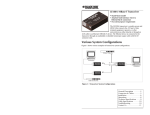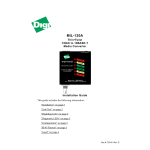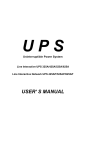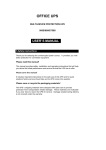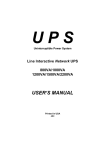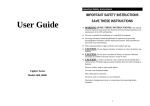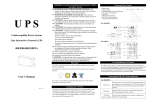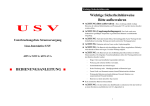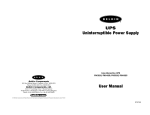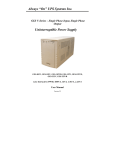Download Rackmount 600VA User`s manual
Transcript
U P S Uninterruptible Power System Line-Interactive Rack-Mount Network UPS 600VA/ 1000VA/ 1200VA 1500VA/ 2200VA/ 3000VA ■USER‘S MANUAL■ TABLE OF CONTENTS INTRODUCTION……………………………………………………………………..i 1. IMPORTANT SAFETY INSTRUCTIONS………………………………………...……………..………1 2. PRESENTATION………………...………….……………………,.………………………..…………2 3. INSTALLATION………………………………………………………………………...……………6 4. OPERATION………………………………………………………………………...………………9 5. SOFTWARE AND COMPUTER INTERFACE………………………………..…………………………10 6. BATTERY CABINET…………………………………………………………………………………11 APPENDIX A. TROUBLESHOOTING……………………………………………………………………11 APPENDIX B. SPECIFICATIONS……………………………………………………….………………12 INTRODUCTION Please read and save this manual! Thank you for selecting this uninterruptible power system (UPS). It provides you with a perfect protection for connected equipment. The manual is a guide to install and use the UPS. It includes important safety instructions for operation and correct installation of the UPS. If you should have any problems with the UPS, please refer to this manual before calling customer service. Please save or recycle the packaging materials! The UPS‘s shipping materials are designed with great care to provide protection within delivery. These materials are invaluable if you ever have to return the UPS for service. Damage happened during transit is not covered under the warranty. Intelligent microprocessor control The UPS is a microprocessor-controlled unit. This means that it operates with the newest technology, high performance and powerful function. The UPS is an intelligent protector and provides pure, reliable AC power to the critical loads - protecting them from utility power blackout, swells, sags and interference. Furthermore, in order to save the battery energy, UPS can automatically turn it off under backup mode if none of the connected loads is operating. Advanced battery management The visual and audible indications of the UPS present the battery’s status. Self-test function let UPS detect a weak battery before it is put into service. The UPS normally perform a self-test at power up condition. i 1. IMPORTANT SAFETY INSTRUCTIONS ● SAVE THESE INSTRUCTIONS - This Manual Contains Important Instructions that ● should be Followed during Installation and Maintenance of the UPS and Batteries. Intend for Installation in a Controlled Environment. ● Servicing of batteries should be performed or supervised by personnel knowledgeable of batteries and the required precautions. Keep unauthorized personnel away from batteries. ● When Replacing Battery, Replace With the Same Number and Type ● CAUTION - Do Not Dispose of Battery or Batteries in a Fire, The Battery May Explode. ● CAUTION - Do Not Open or Mutilate the Battery or Batteries, Released Electrolyte is Harmful to the Skin and Eyes. It May be Toxic. ● CAUTION - A Battery can present a Risk of Electrical Shock and High Short Circuit Current. The Following Precautions Should be Observed When Working on Batteries: Remove watches, rings or other metal objects. Use tools with insulated handles. Wear rubber gloves and boots. Do not lay tools or metal parts on top of batteries. Disconnect charging source prior to connecting or disconnecting battery terminals. 1 2. PRESENTATION Front Panel (600VA/ 1000VA), 1U size Front Panel (1200VA/ 1500VA), 2U size Front Panel (2200VA/ 3000VA), 3U size 2 Back Panel (600VA/ 1000VA), 1U size Back Panel (1200VA/ 1500VA), 2U SIZE (1500VA/110V NO BYPASS OUTPUT) 3 Back Panel (2200VA), 3U SIZE Back Panel (3000VA), 3U SIZE 4 2.1 “Power On” Indicator Power On indicator illuminates when utility power’s condition is normal. 2.2 “BACKUP” indicator The indicator illuminates when the power is supplied from the batteries. 2.3 “Battery Fault” Indicator This illuminates indicating weak battery. Recharge the battery for at least four hours. If after recharging this still illuminates, replace the battery by following the instructions in the manual.(You can plug out then check battery) 2.4 Power Switch Can be used as the master on/off switch of your equipment by leaving your equipment connected to UPS and switched on. 2.5 UPS Outlets Provide instantaneous back-up power protection to your equipment. Supply temporary uninterrupted operation for your equipment during power failure. 2.6 Bypass Power Sag Outlets Provides bypass power sag protection to your equipment. Prevent power problems traveling through your system via unprotected peripherals. 2.7 Circuit Breaker Protection Serves as an overload and fault protection. This is a critical component of the advanced UPS 2.8 “Phone Jack” Communications Ports Telecom transfer ports provide users to extend the applications. ●Caution: To reduce the risk of fire, use only No. 26AWG or larger telecommunication line cord. 2.9 communication function Provide RS-232 interface and UPSMON software to support NOVELL, UNIX, DOS, WINDOWS and other operating systems. 5 3. INSTALLATION Inspect the UPS upon receipt. The packaging is recyclable; keep it for reuse or disposed of properly. 3.1 Recharge the battery UPS may be used by anyone immediately upon receipt. The battery is fully charged before shipped from the factory. However, user is recommended to recharge the battery at least eight hours before using UPS. Energy loss may occur during shipping or long duration storage. To recharge the battery, simply let UPS be plugged into an AC outlet and switch it on. 3.2 Connect the loads Plug your primary equipment (e.g. computer, monitor and critical data storage device, etc.) to the Battery Power-Supplied outlets. Plug your peripheral equipment (e.g. printer, scanner, fax, or audio device) to the bypass outlets. Do not plug laser printer to the UPS output outlets, as its power demand is much higher than typical peripherals and may cause the circuit breaker to trip. It is suggested to connect the similar heavy loads (like laser printer) to the bypass outlets. 3.3 Connect the telephone If you wish to protect a fax or a modem, connect the telephone cable from the wall outlet to the “IN” jack. Connect the telephone cable (provided) from the “OUT” jack to the fax or modem. To protect a10Base-T (UTP) network interface, obtain and use a UTP cable to connect the “OUT” jack to your computer. 3.4 Connect to the utility power Plug UPS to a 2-pole, 3-wire grounding receptacle. Make sure the branch is protected and does not service equipment requiring heavy electricity (e.g. refrigerator, air conditioner, copier, etc.). Avoid using extension cords; if used, make sure they are rated for at least 15 Amps (A). 3.5 UPS self-test UPS will conduct a self-test once switched on it each time. Do not add or take off any equipment while UPS conducts self-test; await it until the Power indicator lights up. Besides this, switch on your equipment after switch on UPS. 3.6 Battery auto-charging Once the power cord is connected, the battery of UPS will be automatically charged by itself. 3.7 Overload protection If an overload situation is detected during self-test, UPS audible alarm will activate, emit a long beep and automatically shut down the system. Unplug at least one piece of equipment from the Battery Supplied Outlets. Switch off UPS, wait 5 seconds and check to make sure the circuit breaker is set then switch on, again. 3.8 Optimal battery status To maintain the optimal status of battery, let UPS be always plugged in. 3.9 Self-protection feature UPS is equipped with self-protection feature preventing people from playing with the unit to subsequently damaging the unit. It is programmed so that once switched off, the user must wait 5 seconds before switching UPS on again. 3.10 Storage To store UPS, cover it and store it with the battery fully charged. During extended storage, recharge the battery every three months to ensure battery life. 3.11 Power failure When the event of power failure occurs after turning on UPS, and prior to the self-test sequence, UPS will automatically shut down and not restart until utility power is restored. This is necessary to check the quality of power that is delivered to your connected equipment. 6 3.12 Installation with accessories of “Rack-mount” types: Please install the rack-mount type units according to the following illustration. I n s t a l l a t i o n wi t h b o t t o m plate. Part R MB - 0 5 1 S E T. I n s t a l l a t i o n wi t h b o t t o m bracket. Part R MB - 0 6 ( 1 U ) R MB - 0 7 ( 2 U ~ 4 U ) . 2 PCS. Installation with rear bracket Part RMB-01(1U),-02(2U), -03(3U),-04(4U) 2 PCS. Step 1 Step 1 Step 1 Step 2 Step 2 Step 2 Step 3 Step 3 Step 3 Step 4 Step 4 Step 4 7 I n s t a l l a t i o n wi t h b o t t o m plate. Part R MB - 0 8 ( 1 U ) , - 0 9 ( 2 U ) ,-10(3U),-11(4U) 2 PCS. I n s t a l l a t i o n wi t h b o t t o m bracket. Part R MB - 1 2 2 PCS. Installation with bracket Part R MB - 1 3 , - 1 4 4 PCS. Step 1 Step 1 Step 1 Step 2 Step 2 Step 2 Step 3 Step 3 Step 3 Step 4 Step 4 Step 4 8 rear 4. OPERATION 4.1 Simple test It is recommended that the user perform a simulation test when using UPS for the first time or when adding an additional piece of equipment. Conduct a simulation-test: first, switch on UPS and wait for the power indicator to light up, then simply unplug UPS to simulate the event of utility failure. 4.2 Check the power requirement of your equipment 4.2.1. Make sure the total power of your equipment does not exceed rating capacity. 4.2.2. Also make sure the equipment you plugged into the Battery Power-Supplied outlets does not require total power exceeding the capacity of the UPS. Otherwise, overload may occur and cause the circuit breaker to trip. If the power requirement of your equipment differs from VA, convert the requirement power into VA by doing the calculations below: 4.2.3. If the power requirement of your equipment is listed other than VA, convert the requirement into VA by doing the calculations below. Watt (W) X 1.67 = model) Watt (W) X 1.67 = model) VA, or Amps(A) X 120= VA, or Amps(A) X 230= VA (For 100-120V VA (For 220-240 4.3 Limited rating power of UPS When utility failure occurs, the UPS output outlets will supply power to your equipment from its battery and the alarm will beep every 5 seconds. Be sure that your equipment is running under the limited rating power. To restore the utility by plugging UPS back in to the existing power source. Repeat the test a few times to make sure UPS works properly and to find out the expected runtime. 9 5. SOFTWARE AND COMPUTER INTERFACE 5.1 Power Monitoring Software The UPSMON series software (or other power monitoring software) is applied standard RS-232 interface to perform monitoring functions, and then provides an orderly shutdown of a computer in the event of power failure. Moreover, UPSMON displays all the diagnostic symptoms on monitor, such as Voltage, Frequency, Battery level and so on. The software is available for DOS, Windows 3.1x, Windows 95/97/2000/ME/XP, Windows NT or later, Novell Netware, Linux and others. Call your dealer for more information on computer OS compatible solutions. 5.2 Interface Kits A series of interface kits is available for operation systems that provide UPS monitoring. Each interface kit includes the special interface cable required to convert status signals from the UPS into signals which individual operating system recognize. The interface cable at UPS side must be connected to REMOTE PORT, at computer side can be either COM 1 or COM 2. The other installation instructions and powerful features please refer to READ.ME file. 5.3 The characteristics of computer interface port The computer interface port has the following characteristics: The communication port on the back of the UPS may be connected to host computer. This port allows the computer to monitor the status of the UPS and control the operation of the UPS in some cases. Its major functions normally include some or all of the following: To broadcast a warning when power fails. To close any open file before the battery is exhausted. To turn-off the UPS. Some computers are equipped with a special connector to link with the communication port. In addition, special plug-in cord may be needed. Some computers may need special UPS monitoring software. Contact your dealer for the details on the various interface Kits. Attention: UPSMON software and interface port function just available for model name with “P” affix. The standard RS-232 cable (pin to pin D-SUB 9 pin cable) can be connected between UPS REMOTE PORT and computer COM port for the UPSMON series software. UPSMON software can be free download from http:// www. pcmups .com.tw 10 6. BATTERY CABINET 6.1 Battery’s life of UPS The battery’s life of UPS is about 3-6 years under normal usage. 6.2 Battery Replacement Once the UPS’s battery is no longer useful and must be replaced. Please call the service personnel to replace it. APPENDIX A TROUBLESHOOTING UPS has a self-protect feature that prevents the UPS from being damaged as a result of overheating. If the temperature is higher than 55°C, wait for a while and let the UPS become cool. Problems Possible Cause Solution Unplug at least one piece of equipment Circuit breaker button Full-time Bypass from the Full-time Bypass outlets. outlets stop providing popped up as a result of Switch off UPS, wait 5 seconds, reset overload. power to the the circuit breaker (press down breaker equipment button), then switch on UPS. Recharge the battery by leaving the UPS doesn’t perform Battery undercharged or UPS plugged in and switched on. to its expected depleted due to frequent runtime. power outages. The power required by your Unplug at least one piece of equipment equipment slightly exceeds from the UPS outlets. the capacity of the UPS. The battery is slightly Call the service personnel to replace the worn-out. battery. UPS cannot be Special UPS is designed to Switch UPS off, wait for 5 seconds, then switch UPS on. turned on. prevent damage from flipping. The battery is worn-out. Replace the battery by following the instructions in this manual. Mechanical problem. Contact your sales representative. 11 APPENDIX B SPECIFICATIONS MO D E L INPUT KIN600 AP/RM 600 Capacity (UPS VA/ outlets) 360W (Bypass 500VA outlets) O U TP U T PROTECTION And FILTERING B A TTE R Y Voltage Frequency Voltage (on b a t t e r y) Frequency (on battery) Voltage Regulation (AVR) KINKINKINKINKIN1000 1200 1500 2200 3000 AP/RM AP/RM AP/RM AP/RM AP/RM 1000 1200 1500 2200 3000 VA/ VA/ VA/ VA/ VA/ 600W 720W 900W 1320W 1800W 500VA 500VA 500VA N/A N/A (220 ~240V only) +/-25% at line input 50 or 60 Hz +/-10% (auto sensing) S i m u l a t e d s i n e wa v e a t 1 0 0 V o r 110V/115V/120Vor 220V/230V/240V +/- 5% 50 or 60 Hz +/- 0.5% AVR automatically increase output voltage 15% above input voltage if –9% to –25% of nominal. AVR decrease output voltage 13% below input voltage if +9% to +25% of nominal Tr a n s f e r Ti m e 2/4 milliseconds, including detection time E MI / R F I f i l t e r 1 0 d B a t 0 . 1 5 MH z, 5 0 d B a t 3 0 MH z Overload U P S a u t o m a t i c s h u t d o wn i f o v e r l o a d Protection e xc e e d s 1 1 0 % o f n o m i n a l a t 6 0 s e c o n d s a n d 130% at 3 seconds Unit Input Circuit Breaker F o r o ve r l o a d & S h o r t c i r c u i t p r o t e c t i o n 10Base-T Cable N e t wo r k ( U TP , R J - 4 5 ) c o m p a t i b l e j a c k s Port Short Circuit UPS output cut off immediately or input fuse protection Ty p e S e a l e d , Ma i n t e n a n c e - f r e e l e a d a c i d Typ i c a l 8 hours (to 90% of full capacity) R e c h a r g e Ti m e Protection Automatic self-test & discharge protection, Replace battery indicator B a c k - u p Ti m e 3– 180 min (depending on computer load) 12 P H YS I C A L Net W eight Kg (lbs) Shipping W eight Kg (lbs) Dimension (mm) W *D*H 9.35 11.5 16.3 16.3 28.4 32.7 (20.5) (25.3) (35.9) (35.9) (62.6) (71.9) 11 13 19.3 19.3 31.1 36.3 (24.2) (28.6) (42.5) (42.5) (68.5) (80) 483*362*44 483*357*84 483*35 483*48 (1U) (2U) 1*130 5.5*130 (3U) (3U) ALARM Battery Back-up Slow beeping sound (about 0.47Hz) Battery Low Rapid beeping sound (about 1.824Hz) O ve r l o a d Continue beeping sound I N TE R F A C E R S - 2 3 2 C p o r t RS-232C Bi-directional communication port Interface 3 , 5 0 0 m e t e r s m a x. e l e v a t i o n , 0 - 9 5 % ENVIRONMENT Ambient Operation humidity non-condensing, 0-40 deg C Audible Noise < 40dBA (1 meter from surface) Storage 1 5 0 0 0 m e t e r m a x. Condition ©2002. August. 07 Version 3.0 All right Reserved. A l l t r a d e m a r k s a r e p r o p e r t y o f t h e i r r e s p e c t i ve o wn e r s . S p e c i f i c a t i o n s s u b j e c t t o c h a n g e wi t h o u t n o t i c e . 6 6 1 - KR 6 0 - 0 0 1 13















